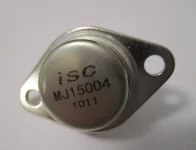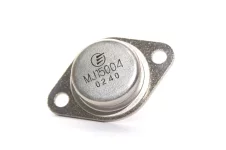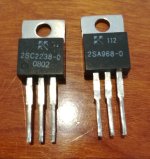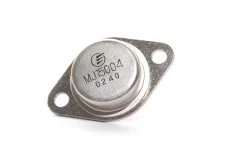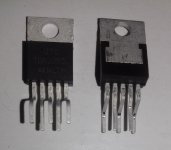If someone wants that part in large quantities, and the exporting country has no restrictions, parts are available, the minimum quantities may put off small quantity buyers.
Here, for the 3055 in particular, CDIL is trustworthy, and the ST may indeed be in production for the Indian market if the quantities justify it, our manufacturing industry is much bigger than the USA for electronic equipment using discrete parts.
BEL is really a defense company, the 3055 that do end up in the civilian market are at times from over production, or off spec 3773 remarked as 3055, which is a lower spec.
They do perform better than 3055 at times, so the impression is that they are fantastic!
The problem is that the BEL item is really a mil grade high quality higher voltage item, much in demand, and sometimes faked (same issue in some values of Keltron capacitors which they do not make or make occasionally due to poor demand, it takes a trader to spot fakes).
As Chris and I have said, it is better to use a reliable part than a fake, I do not know if the sound quality is different for the same part between brands, that seems unlikely.
More likely is equipment damage from bad parts, should be avoided.
Here, for the 3055 in particular, CDIL is trustworthy, and the ST may indeed be in production for the Indian market if the quantities justify it, our manufacturing industry is much bigger than the USA for electronic equipment using discrete parts.
BEL is really a defense company, the 3055 that do end up in the civilian market are at times from over production, or off spec 3773 remarked as 3055, which is a lower spec.
They do perform better than 3055 at times, so the impression is that they are fantastic!
The problem is that the BEL item is really a mil grade high quality higher voltage item, much in demand, and sometimes faked (same issue in some values of Keltron capacitors which they do not make or make occasionally due to poor demand, it takes a trader to spot fakes).
As Chris and I have said, it is better to use a reliable part than a fake, I do not know if the sound quality is different for the same part between brands, that seems unlikely.
More likely is equipment damage from bad parts, should be avoided.
Completely agree. Although we can use those for non critical work by varifying their performance & capabilities.A newly manufactured part marked with an old number made by a different manufacturer without license is a fake. Pure and simple. The lack of complete data is a giveaway too. Any expectation it will perform the same is wishful thinking.
Anyway, this is how Genuine ST 2N3055 looks like (Laser engraved?) & i've never seen a new original one in my entire life (at local store or distributors) after ST discontinued it. CDIL or BEL make is available everywhere though.
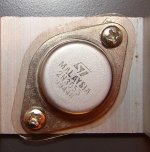
I found on ebay, ISC MJ15004 and this other one where I don't know which manufacturer has this kind of logo. I'm assuming this is considered a copy and not a fake transistor. It has the manufacturer's logo, they don't hide behind ON.
Attachments
From my experience, the only companies that still produce copies of obsolete transistors today (Attention: copies not fakes!) are: CDIL, PMC, ISC and MAGNATEC.
The specimens from these manufacturers that I have used have always worked well without failures and/or explosions.
However, I cannot guarantee whether these copies are exactly the same and with the same excellent performance as the originals.
The specimens from these manufacturers that I have used have always worked well without failures and/or explosions.
However, I cannot guarantee whether these copies are exactly the same and with the same excellent performance as the originals.
For example, these transistors in the photo are copies of the famous Toshiba stage drivers produced by MAGNATEC.
I purchased them from RS Components and mounted them in my 200W rms mosfet amplifier.
They work perfectly.
The amplifier faithfully reflects all laboratory tests and feels wonderfully good!
I purchased them from RS Components and mounted them in my 200W rms mosfet amplifier.
They work perfectly.
The amplifier faithfully reflects all laboratory tests and feels wonderfully good!
Attachments
Around this neck of the woods it’s UTC (only place you can get TDA2050’s that actually work, BTW), KEC, Mospec and (ugh) Solid State Inc. Same caveats apply. Anatech’s position is that any such transistor or IC is a fake, and he’s not really wrong. 2SABCDJK parts were originally supposed to be manufacturer specific. Each had their own type number even if what they made had the same spec and could be used interchangeably. On the other hand, JEDEC and equivalent EU types were intended to be generic. An SGS 2N3055 was not considered fake even though it was NOT an RCA.
Those ISC MJ15004’s are probably as good as Mospec. Good as an old Motorola from the 90’s? Probably. Good (uniformity wise) as the latest batch of ON? I wouldn’t bet on that. The truth of it is, those parts just aren’t that hard to make, to older standards. Even sustained-beta drivers aren’t a stretch to make anymore - NONE of them have spectacular ruggedness, they never did. Properly sized, they don’t need it. Just a flat beta to maybe half an amp, respectable fT, 25 watts power handling to about 30V, and be able to block 200V or so at Vbe=0. Makers are coming out of the woodwork. Just don’t try it with a 2SC2922. Those from ISC simply blow up. To make one that good requires Sankens original processing and assembly technique. If I had to venture a guess I’d say they either put the same die in that as the metal MJ15004, or the one out of their 2SC5200 copy if they have one. The result of that is instant smoke and fire when using a single pair on a +/-70V supply. When Sansui, Pioneer, and others used the Sankens above ratings with their 90’s amps and receivers they at least made it through the warranty period.
When these things are all one can get in their country due to import laws, minimum orders, or even stuff ordered from Mouser not making it through customs, you’ve got to do what you’ve got to do. It also means doing your homework, and some things just aren’t possible. Kids with a $50 or $100 a year budget fall into the same trap. But they should be used to doing homework. At the same time as silicon processing is hitting full maturity and more available than ever, the market is flooded with outright fakes that will fry the instant you turn the thing on, even on a dim bulb.
Those ISC MJ15004’s are probably as good as Mospec. Good as an old Motorola from the 90’s? Probably. Good (uniformity wise) as the latest batch of ON? I wouldn’t bet on that. The truth of it is, those parts just aren’t that hard to make, to older standards. Even sustained-beta drivers aren’t a stretch to make anymore - NONE of them have spectacular ruggedness, they never did. Properly sized, they don’t need it. Just a flat beta to maybe half an amp, respectable fT, 25 watts power handling to about 30V, and be able to block 200V or so at Vbe=0. Makers are coming out of the woodwork. Just don’t try it with a 2SC2922. Those from ISC simply blow up. To make one that good requires Sankens original processing and assembly technique. If I had to venture a guess I’d say they either put the same die in that as the metal MJ15004, or the one out of their 2SC5200 copy if they have one. The result of that is instant smoke and fire when using a single pair on a +/-70V supply. When Sansui, Pioneer, and others used the Sankens above ratings with their 90’s amps and receivers they at least made it through the warranty period.
When these things are all one can get in their country due to import laws, minimum orders, or even stuff ordered from Mouser not making it through customs, you’ve got to do what you’ve got to do. It also means doing your homework, and some things just aren’t possible. Kids with a $50 or $100 a year budget fall into the same trap. But they should be used to doing homework. At the same time as silicon processing is hitting full maturity and more available than ever, the market is flooded with outright fakes that will fry the instant you turn the thing on, even on a dim bulb.
Last edited:
Yes, JIS standards meant that a part number also specified the manufacturer. No deviations. European and North American standards bodies specified a type number that the part had to match for most specs. Back in the day, the brand of transistor with the same type number needed differing compensation components in the amplifier. The bad old days. This is probably why the JIS standard is what it is.
I don't know. I guess sometimes the hard call is that an item is not repairable. I know when I do a repair and have no good sub, I kick it out as not repairable. There are times when I design a new amplifier or regulator PCB and circuit if there are enough units out there. But, this is the choice.
If you make a repair that fails, you lose your original service charge, and if nothing else, the other parts you installed and you still have a blown unit. The very most expensive thing you have to do is re-repair an item, or refund money after working on it. Your reputation takes a big hit too. Not worth it in my book.
My training was pretty simple. Do it right (properly) or don't touch it. This means the right parts, procedures and knowledge. If you don't have the required equipment, you can't do the job properly. I can't tell you how many items I get in that "sounds perfect" with high distortion that pointed to another fault in a circuit not repaired correctly. If you are building or designing something, how much time do you waste chasing a fault that turns out to be a part? It just isn't worth it. A used part (pull) is worth far more than a fake, or newly manufactured part that isn't 100% compatible.
This isn't a privileged viewpoint. It is reality. Things either work right, or they don't. They either fail, or they don't. When you don't have much money, getting it right is the least expensive way and therefore the most important thing for you. Also, speakers are more expensive sometimes than the amplifier driving them. I have seen speaker fires.
-Chris
I don't know. I guess sometimes the hard call is that an item is not repairable. I know when I do a repair and have no good sub, I kick it out as not repairable. There are times when I design a new amplifier or regulator PCB and circuit if there are enough units out there. But, this is the choice.
If you make a repair that fails, you lose your original service charge, and if nothing else, the other parts you installed and you still have a blown unit. The very most expensive thing you have to do is re-repair an item, or refund money after working on it. Your reputation takes a big hit too. Not worth it in my book.
My training was pretty simple. Do it right (properly) or don't touch it. This means the right parts, procedures and knowledge. If you don't have the required equipment, you can't do the job properly. I can't tell you how many items I get in that "sounds perfect" with high distortion that pointed to another fault in a circuit not repaired correctly. If you are building or designing something, how much time do you waste chasing a fault that turns out to be a part? It just isn't worth it. A used part (pull) is worth far more than a fake, or newly manufactured part that isn't 100% compatible.
This isn't a privileged viewpoint. It is reality. Things either work right, or they don't. They either fail, or they don't. When you don't have much money, getting it right is the least expensive way and therefore the most important thing for you. Also, speakers are more expensive sometimes than the amplifier driving them. I have seen speaker fires.
-Chris
The thing is UTC, KEC, MOSPEC, CDIL all are well-known second source & they works as expected (more or less). But the problem is with unknown manufacturer like this... do you know anything about the brand? So far we got no information about that. So why take chance?
View attachment 1371432
So are you going to rip one open and stick another couple on an SOA tester or is someone else? No one will know a thing until somebody tries and reports back. I’ve never even seen that logo before from any place I’ve used in the past, and I don’t go scouring EBay looking for parts. Hell, since COVID, even my surplus hunting days are pretty well over. And with it my last sources of $3 heat sinks and $20 donor transformers. The cost of MJ15004’s isn’t even the real loss here.
I don't consider buying unknown part from 'ebay', not even known type. On the other hand if i got something like that from trash i would like to see how good or bad it is because of curiosity only!
nixie62 mentioned being able to get them “from a local store cheaply” so I guess he’ll have to volunteer. I used to do that at Skycraft and Tanners all the time. And the fakes were few and far between, actually. Most notably was the batch of ST 2N3055’s I mentioned. I knew they looked fishy, so I cracked the top hat right off in the store. Still that must have been 5 years ago now. Must have scored a couple hundred old stock Motorolas over the years. Equally many “Je ne sais quoi” house numbers, most perfectly suitable for 80-100 volt audio use. Some higher, including house number “2N6259’s” that actually appear to be what here-say says they were.
I asked the local dealer who the manufacturer is, he also says ISC, which is obviously not correct. I asked an ebay seller about that 15004, he has no idea who the manufacturer is. There are just 9+13 pieces 15022/23 in the store. I won't take them, it's no use wasting money and time. About 2.2 euros a piece, but all the same, tooo risky. I thought it was some verified manufacturer, but no one knows that logo. In addition, another seller has CDIL 15022/23 a little more expensive, about 3eur a piece. It's not about money in general, I'll get Mouser ON originals at the first opportunity.
Last edited:
I have used these TDA2050 from UTC two times not long ago and they worked just fine , even close to the prescribed max voltage.Not only works, it met all the specs. It can withstand absolute maximum supply voltage of +/-25vDC with 4ohm load ! Although heatsink becomes super hot!!
View attachment 1371436
The thing is because of today's technological advancement it is not difficult to make 80's or 90's transistors (same spec, same capabilities) for any semiconductor manufacturer. So if you want to buy something that is obsolete by original manufacturer, look for reputed second source like UTC, KEC or Mospec. For me Korean & Taiwanese manufacturers are far more honest than Chinese second source. At least they try to deliver their best.
You are correct - as long as they take the care to keep their processes in control, silicon pure and artwork the same. My experience is that these things are not true. As for Korean and Taiwanese manufacturers, I have more experience with Korean. I'll agree they are a viable source.
Like anything, it comes down to quality control. If they cut costs, it will show up in the product.
Like anything, it comes down to quality control. If they cut costs, it will show up in the product.
I have read somewhere that UTC TDA2050L is somewhat better sounding than original ST part due to more 2nd harmonics. I have seen measurement data. I think internally they're not the same although their datasheet is identical.
Advances in technology mean that the same chip can be made smaller, and can run at a higher temperature than the original, and the silicon itself is purer.
But how much is needed to make a TDA series chip?
The Chinese 'good brand' 2030/2050/1875 are in the 25 cent range here, and the UTC is a $0.50 part here, if available, it does not sell much in my neck of the woods.
The UTC datasheet is a scan and change font copy of the original ST datasheet....in any case, it is a reputable company which makes parts that are at times not made by the original makers, they also have a line of Hall effect sensors etc. for automotive use IIRC.
No ties to any names here, as usual.
But how much is needed to make a TDA series chip?
The Chinese 'good brand' 2030/2050/1875 are in the 25 cent range here, and the UTC is a $0.50 part here, if available, it does not sell much in my neck of the woods.
The UTC datasheet is a scan and change font copy of the original ST datasheet....in any case, it is a reputable company which makes parts that are at times not made by the original makers, they also have a line of Hall effect sensors etc. for automotive use IIRC.
No ties to any names here, as usual.
Well ... no. Silicon can only run so hot before it melts or gets really leaky. The chip isn't smaller, but the artwork is finer. For "x" amount of dissipation you need a certain area for the same reliability, and heat is always your sworn enemy.
You cannot fight physics, it will show you how wrong you are every single time. If the die is smaller, it runs hotter and on average won't last as long. But they only care about warranty period these days.
Yes, the silicon can be made more pure, but to save money they may not do that.
You cannot fight physics, it will show you how wrong you are every single time. If the die is smaller, it runs hotter and on average won't last as long. But they only care about warranty period these days.
Yes, the silicon can be made more pure, but to save money they may not do that.
Well, yes, I agree, but the TDA series was a 1970s design, some tweaks to the processes have occurred, and I have little detailed knowledge of that.
So I must respect your experience on this topic.
To repeat, we must stick to known good parts, there are many part makers in China doing huge volumes in electric vehicles (and their chargers), solar systems, LED lighting, appliance drives and so on, with almost all the product going into OEM boxes, and not showing up in the replacement market.
Many are Mosfets and PWM parts, not really audio grade parts.
Those that do appear in small quantities may be off spec rejects, so buyer beware, stick to good quality parts from known makers and sellers.
So I must respect your experience on this topic.
To repeat, we must stick to known good parts, there are many part makers in China doing huge volumes in electric vehicles (and their chargers), solar systems, LED lighting, appliance drives and so on, with almost all the product going into OEM boxes, and not showing up in the replacement market.
Many are Mosfets and PWM parts, not really audio grade parts.
Those that do appear in small quantities may be off spec rejects, so buyer beware, stick to good quality parts from known makers and sellers.
- Home
- Design & Build
- Parts
- My Transistors, original or copy?
